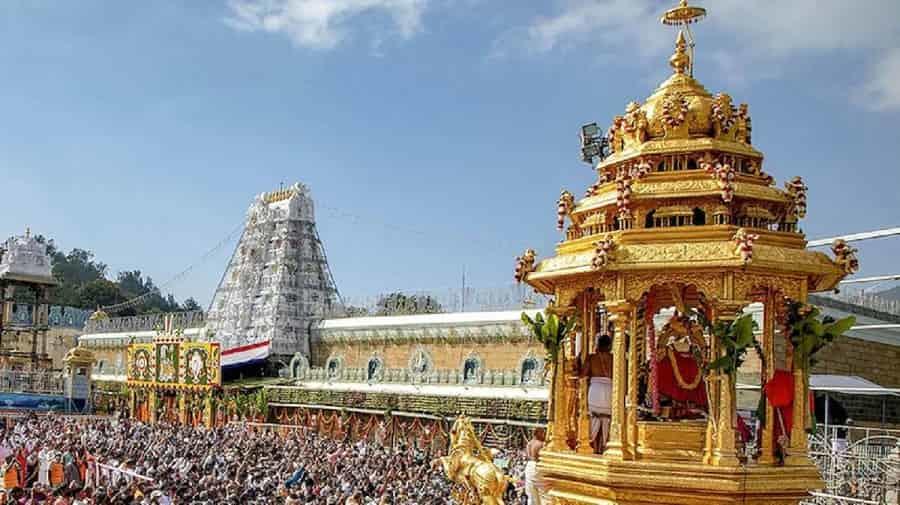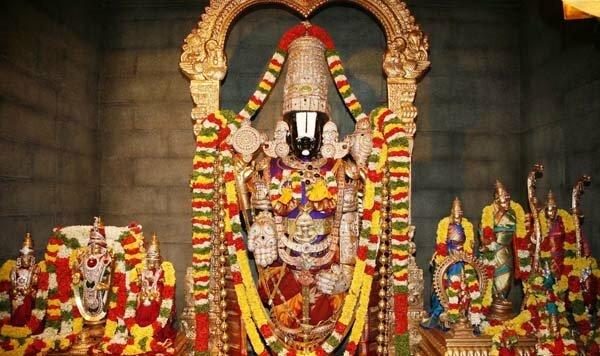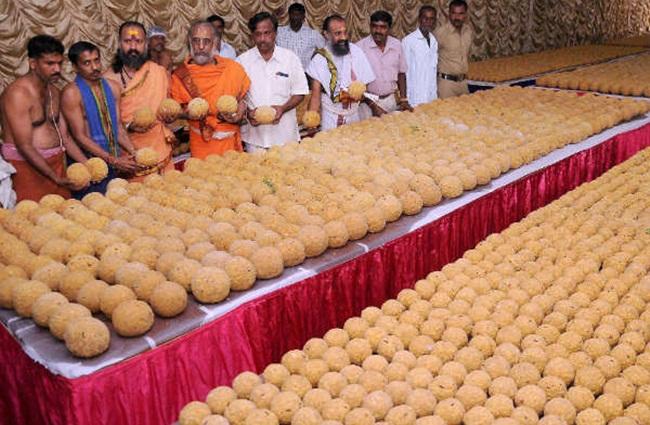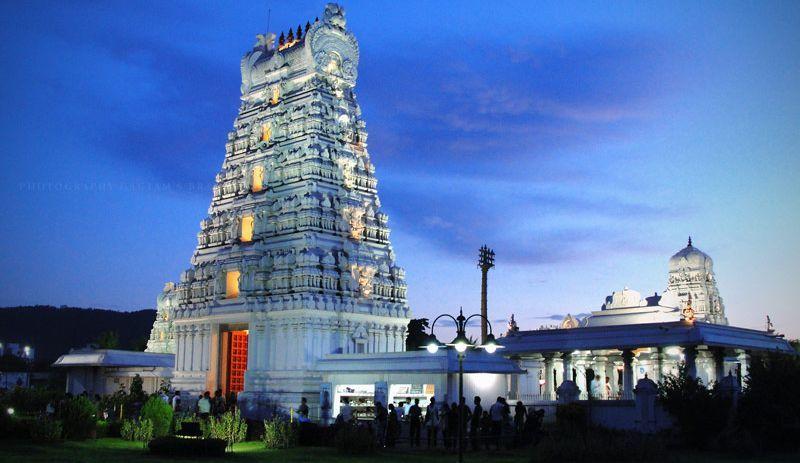Located in the town of Tirupati in the Indian state of Andhra Pradesh, this magnificent temple, dedicated to Lord Venkateswara, also known as Balaji, is a testament to the rich cultural and spiritual heritage of India. Millions of devotees from all corners of the globe flock to this sacred place every year, one of the most sacred temples in Hindu mythology, to seek the blessings of Lord Balaji and experience the divine aura that surrounds the temple.

Tales of Lord Vishnu at Tirupati Balaji
The history of Tirupati Balaji Temple dates back to ancient times, with its origins shrouded in legends and myths. According to Hindu mythology, Lord Venkateswara, an incarnation of Lord Vishnu, descended to earth to bless his devotees and alleviate their sufferings during this age, the Kali Yuga (which is said to have begun in 3102 BCE, and will end in 428,899 CE). Tirupati Balaji was his abode for the duration of the Kali Yuga.
The Beginning
The most popular story of the significance of the temple is an intricate tale about how Lord Vishnu came to be earthbound in this location.
It is said that Sage Brighu wanted to see which deity was the greatest of the Holy Trinity (Vishnu, Brahma, and Shiva), worthy of receiving the benefits of a holy yagna being performed. So, he visited Brahma and Shiva and was not satisfied with their demeanour or welcoming. When he visited Vaikuntha (the abode of Vishnu at the time), he expected to be just as disappointed as before (and some versions say Vishnu was asleep, enraging Brighu) so he kicked Vishu in the chest straight away.
Vishnu, rather than attack Sage Brighu back, massaged the man’s feet since they had been injured during the kick, in a show of empathy. Vishnu also took the opportunity to crush the extra eye on Brighu’s soul, which destroyed the man’s ego and showed him the error of his behaviour. Finally, Sage Brighu was reformed and convinced that Vishnu was the best deity.
Lakshmi’s Departure
Goddess Lakshmi, who resides in the chest of Lord Vishnu, felt insulted that she was kicked and that Vishnu didn’t even defend her. So, she left Vaikuntha and went to Earth to meditate (or performed a 12-year penance so intense it scared the other deities, depending on the story). Either way, she was convinced to stop penance and instead become reincarnated as Princess Padmavati, the daughter of King Akasha Raja.
Meanwhile, a devastated Lord Vishnu went to find Lakshmi, but could not find her because she had already reincarnated. So, he retreated into an anthill on Venkata Hill to meditate on Lakshmi.
The Reunion
Eventually, Vishnu himself reincarnated as Venkateshwara (also called Srinivasa). He would then meet Padmavati, and their celestial love story picked back up. They were again to be wed.
It is said that Lord Venkateswara borrowed a huge sum of money from the god of wealth, Kuber, to conduct a grand wedding ceremony.
Then, it is said that Venkateswara, Padmavati, and Laskhmi all turned to a swayambhu stone murti on the seven hills, so that they may be present through the rest of the Kali Yuga.
The Inception of the Temple
The actual temple structure is said to have been first built when ancient ruler Thondaiman was told by Lord Vishnu to begin construction in a dream. Thondaiman arranged for the first iteration of the structure where the stone murti lay, as instructed. He built the Gopuram and the Prakaram and arranged for regular prayers to be held at the temple.

History of Tirupati Balaji Mandir
According to historical records, the temple is believed to have been built around 2,000 years ago, indeed by Thondaiman of the Pallava dynasty (estimated around 300 AD). Since then, it has been patronized by various rulers and dynasties over the centuries, including the Cholas, Vijayanagara Empire, and the British.
The Temple Over the Years
Historical records provide valuable insights into the origins and development of the Tirupati Balaji temple. The earliest references to the temple can be found in ancient Tamil literature, particularly the Sangam poetry from the 9th century CE. These poems mention the temple and the rituals performed there, indicating its prominence in the region even during ancient times.
The temple is also mentioned in scriptures like the Garuda Purana and the Brahma Purana.
During the Vijayanagara Empire in the 14th to 16th centuries, the temple underwent significant renovations and expansions under the patronage of Emperor Krishnadevaraya. The temple saw the construction of the monumental entrance tower, Rajagopuram, and the implementation of administrative and ritualistic practices that continue today.
The temple also faced challenges during the period of Muslim rule, as the region came under the control of various Muslim dynasties. However, the temple managed to survive thanks to the efforts of local rulers who continued to patronize and protect it. The temple's treasures were hidden to protect them from plunderers, and its rituals were carried out in secrecy.
In the 18th century, the Maratha rulers played a pivotal role in restoring the temple to its former glory. They protected the temple and made significant contributions to its wealth and resources.
During British colonial rule, the temple came under the control of the British government, but they adopted a policy of non-interference, allowing the temple to continue its activities without much interference.
What’s In a Name?
There are many names associated with deities in Hinduism. As a result, many things go by different names.
Lord Vishu is also known by names like Balaji, Govinda, and Srinivasa.
At Tirupati Balaji temple, he is known as Lord Sri Venkateswara. But, he also goes by the name Kaliyuga Prathyaksha Daivam (the Manifested Lord of the Kali Age) because the temple is that of this Kali Yuga. Therefore, the temple can also be called Kaliyuga Vaikuntham (one of the 108 Vaishnava Divya Desam of the Kali Age).
The official name of this temple is Sri Venkateswara Swamy Temple, but it is also known as Tirumala Temple and Tirupati Temple.
Modern History
In the middle of the 18th century, the Maratha General Raghoji I Bhonsale conceptualized a permanent body to administer the temple proceedings. This led to the establishment of Tirumala Tirupati Devasthanams (TTD) in 1933, which manages and maintains the temple and its sub-shrines.
The TTD manages the temple's finances, properties, and day-to-day operations. They have implemented various initiatives to improve the temple's infrastructure, including the construction of new guesthouses, dining halls, and queue complexes to accommodate the ever-increasing number of devotees.
Now, Tirupati Balaji Temple is the wealthiest in the world thanks to its daily received donations from devotees. In 2022, the temple received an average of 40.4 million rupees (4.04 crore) per month in donations (total: 484.6 million rupees or 48.46 crores). But, it can be hard to measure the exact amount because there are many different ways the temple receives donations.
It is also the most-visited holy site in the world, with an average of 50,000 to 100,000 pilgrims each day (30-40 million people annually on average). On special occasions, like Brahmotavam, the number of pilgrims can be as many as 500,000 in one day.


Cultural Significance
There are many reasons why this temple is still so worshipped today, and there are many ways devotees can show their worship as well.
One of the Divya Desams
According to tradition and ancient texts, there are 108 Divya Desams, which are the most holy of all Vishnu temples according to the Tamil Azhvars.
One of Eight Swayambhu Kshetras
Tirupati Balaji is one of eight Swayambhu Kshetras (aka Ashtakshara) where the form of the deities have self-manifested.
Built Upon Sheshnag’s Hood
The Seven Hills of Tirumala represent the hoods of the serpent (cobra) god, Sheshnag. The hills are called Saptagiri, and Tirupati Balaji Temple is built upon the hill named Venkatadri. This is why the temple can also be called Sri Venkateswara Swamy Temple, and Lord Vishnu can also be called Lord Venkateshwara.
Offerings Devotees Can Make
Since Tirupati Balaji is the most popular temple for pilgrimage, there are many methods by which devotees can make offerings and donations.
- Hair Tonsuring (Mundan) - While Lord Balaji was on Earth, he suffered an injury to the head that left him with a bald spot. Neela Devi, Balaji’s foster mother at the time, cut her beautiful hair and held it to his bald spot. Her hair healed the injury and attached to Balaji’s head, filling in the bald spot.
Lord Balaji proclaimed that anyone who sacrificed their hair to him would have their blessings granted. It’s also said that Lakshmi grants blessings for hair offerings, too.
500 - 600 tonnes of hair are donated every year at Tirupati Balaji. The temple sells the hair and the money goes towards the temple upkeep. - Thula Bharam Seva - Devotees can donate offerings equal in weight to their bodies when weighed on a Thula.
- Monetary donations to pay back Kubera’s Loan - Since Lord Venkateshwara took an immense loan from Kubera to throw a lavish wedding to Padmavathi, it’s believed he still owes a lot of money. Devotees can help reduce the debt with donations placed in the Hundi.
Festivals and Unique Sevas
The Tirumala Tirupati temple celebrates over 433 festivals per year, suiting the title "Nitya Kalyanam Paccha Toranam" where every day is a festival.
The most important festivals are Brahmotsavam, Vaikunta Ekadasi, Rathotsavam, Ugadi, Rama Navami, Krishna Janmashtami, Diwali, and Navaratri.
The temple also boasts some proprietary practices. As part of prasadam, the temple distributes Tirupati Laddu, which are so specialized that they have received a Geographical Identification Tag (GI), which means they can only be made and sold by Tirupati Tirumala Devasthanams at the temple.
Furthermore, the flowers, milk, butter, and leaves used in the Balaji worship rituals are from an unknown village nearby. No one is allowed to know the village or go there except its inhabitants.
Tirupati Balaji Temple Timings
The temple follows the elaborate ritual schedule designed by Saint Ramanujacharya in the 11th century. There are numerous daily, weekly, and periodic poojas and sevas.
Prayers start at 3 am and end with Ekanta Seva (a ritual in which a priest sings lullabies to put the lord to sleep) at 1 am.
For the full list of timings, you can look at the official schedule.

Planning Your Visit to Tirupati Balaji
When planning your visit to the temple, there are a few things you need to know.
Where is Tirupati Balaji Temple?
Tirupati Balaji Temple is located in Andhra Pradesh.
The full address is: S Mada St, Tirumala, Tirupati, Andhra Pradesh 517504
How to Get to the Temple
You can reach the temple by road, rail, and air.
By road, you may drive or take a bus from nearby cities like Chennai, Bengaluru, and Vellore. There is also a bus service between Tirupati and Tirumala. You may also hire a taxi.
By rail, the nearest train station is Tirupati Station, 26 km away from Tirumala. It is well-connected to other cities. You can hire a taxi to and from the station and the temple.
By air, the closest airport, Tirupati Airport, is only 40 km away from the temple. The second nearest airport is Chennai, which is 143 km away.
Dress Code, Entry Fee, and Conduct
In 2013, the TTD introduced a dress code for the temple. Depending on what activity you are participating in, you will need to wear certain clothing. It’s best to wear all traditional clothing, or else you may be barred from entry or participation in certain events.
Bermuda shorts, t-shirts, pants, shorts, or any Western-style outfit that shows inappropriate body parts is strictly prohibited.
Men: Dhoti, white kurta, white pancha, or pyjama
Women: Saree with a blouse, Punjabi dress with dupatta, Chudidhar with dupatta, or half saree.
There is no entry fee to get into the temple, but there is an option for VIP Darshan which costs Rs. 300 per person. Many of the sevas also cost about Rs. 200 per person.
You must bathe and remove your shoes before entering the temple.
Photography, smoking, drinking alcohol, eating non-vegetarian foods, and disruptive behaviour are strictly prohibited.
References
- “History of Tirupati.” Tirumala Tirupati Darshan Seva Room Online Booking, 14 Sept. 2018, www.tirumalatirupati.in/history-of-tirupati/.
- “Temple Legend.” Tirumala Tirupati Devasthanams (Official Website), www.tirumala.org/TempleLegend.aspx. Accessed 27 Nov. 2023.
- “Tirupati Balaji Temple, Andhra Pradesh - Info, Timings, Photos, History.” TemplePurohit, www.templepurohit.com/hindu-temple/tirupati-balaji-temple/. Accessed 27 Nov. 2023.















